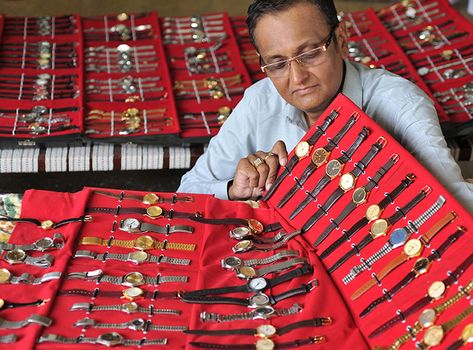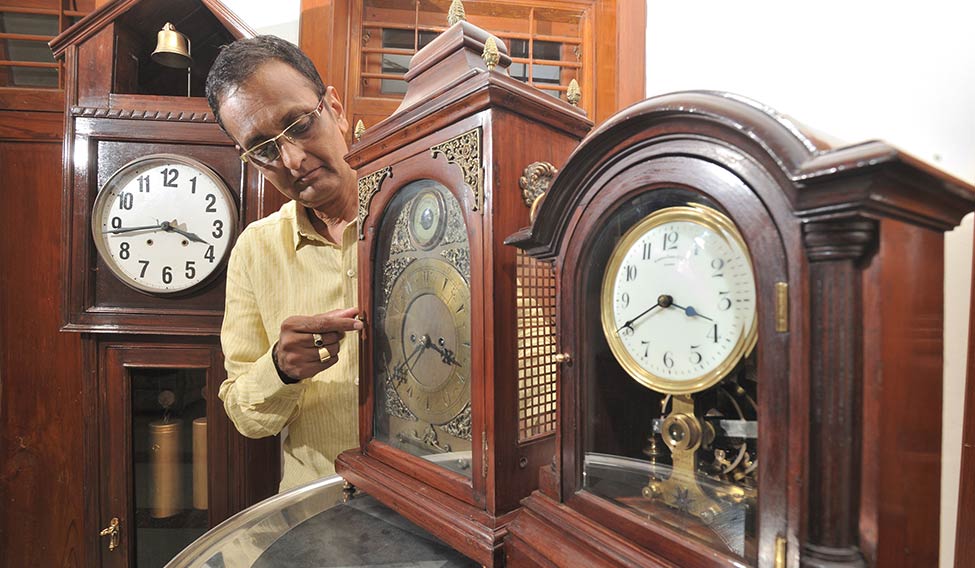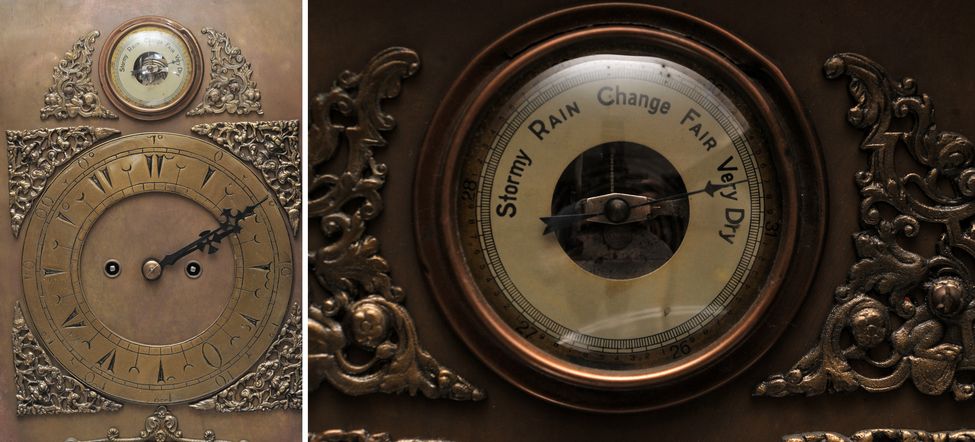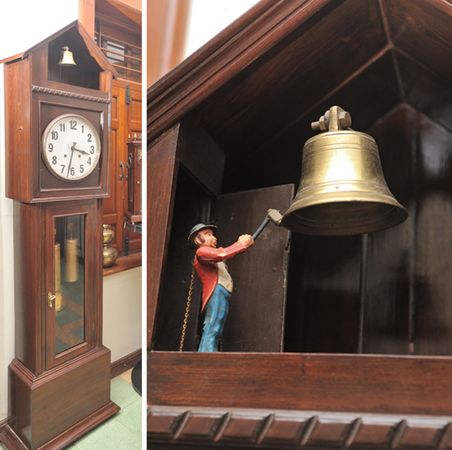It is a blistering afternoon in Bhavnagar, a sleepy district in Saurashtra, Gujarat. The time is perfect for a siesta. Suddenly, however, as the clock strikes one, a liveried man rushes out of a door, hammering a bell, shaking me out of languidness. And, once he is sure that he has got my attention, he disappears, leaving behind the doors shut.
This is no bizarre tale; I am talking of a grandfather clock from 1800, replete with a striking mechanism. This grandpa is one of the star attractions among entrepreneur Rajesh Vyas’s collection of 60 vintage clocks.
Born and brought up in Bhavnagar, Vyas (54), loves these mechanical wonders and has refurbished many of them with great care. “I still remember the cuckoo clock, which I built in school as part of a project,” says Vyas. “I have been collecting clocks and watches since 1983. I was attracted by the designs of various models, the complex movements and the wooden cases they were housed in. As I am a mechanical engineering graduate, I can dismantle and repair movements.”
 Vyas also collects HMT watches and owns 210 timepieces
Vyas also collects HMT watches and owns 210 timepieces
Practice makes perfect, he adds. “I have not received any formal training in repairing clocks. I try to understand the basic design of the movement, and I remove the faulty parts and manufacture new ones with identical dimensions and design,” he says. “Luckily for me, all the clocks I have repaired are working smoothly.”
For Vyas, repairing vintage clocks is not a challenge, but sourcing them is. “With technological advancements, it is possible to manufacture almost all parts if you have an original sample. If not, one can import them,” he says. “But finding the clocks is quite a task. Most of them are from Germany, England and America. They are rare in India, and, even if people own them, they are not restored and usually land at a scrap dealer’s place.”
With a few clocks passed on from his grandfather, Rajesh’s collection comprises table clocks, wall clocks and grandfather clocks. He also collects marine artefacts in brass and copper, such as navigation tools and chronometers, which occupy certain corners at his office-cum-workplace in his ancestral house.
“I have bought clocks as cheap as Rs 4,000 as well as spent up to Rs 1.5 lakh on a Grandfather clock,” says Vyas. One can find clocks ranging from companies such as West End Watch Co., John Walker, Seth Thomas, Schatz, Ansonia and Junghans to unnamed masterpieces.

“Of these, the Brillie is very important,” he says. “The 1905 clock was designed by Lucien Brillie, a French engineer, to transmit signals to regulate slave clocks. It is an electric clock with a horseshoe magnet. In those days, they used to install it on a marble slab.”
The Brillie clock, he says, was originally owned by the Junagadh Royal family, but changed hands after they fled. “I was informed that this clock was lying with a scrap dealer in Junagadh,” says Vyas. “And, upon visiting the place, I found the clock in a pathetic state—the case was damaged and the legs were wobbly.”

He had to change the case wood, legs and the dial and pendulum, which were originally in gold. “I gave electric supply to the coil using a battery and checked for the current using a multimeter,” he recalls. “As there was a slight movement of the magnet, I quickly purchased it for Rs 70,000.”
The Eureka clock, made in England in 1906, is one of the finest clocks he has ever seen, says Vyas. “This was lying with one of my uncles who could not get it repaired. I purchased it for Rs 50,000,” he says. “The most attractive feature about this clock is the huge balance wheel, which rotates clockwise and anti-clockwise. Today, its worth must be about Rs 2 lakh, but I do not intend to sell it.”
 The striking mechanism in this grandfather clock from 1800, chimes every half-an-hour.
The striking mechanism in this grandfather clock from 1800, chimes every half-an-hour.
Another favourite, he says, is the 1910 Fusee Chain Clock. “This movement was usually found in railway clocks. I got it from a person in Mumbai, when he failed to get it fixed,” he says. “I paid about Rs 60,000 in 2001, and replaced the dome and escapement wheel.”
How does one ensure the authenticity of these pieces? “Most of the times, the original certificates are missing. But if you look at the condition of the clock, and the parts that are missing or damaged, an experienced collector can easily gauge the worth,” says Vyas. “The dial is a huge giveaway because, in those days, they were either hand-painted or printed on paper. However, most of these clocks come with reproduced dials.”
Even as he emphasises the importance of maintenance and service, Vyas says taking care of clocks is a time-consuming job. “Depending on the power reserve, one has to wind them once every eight, fifteen or twenty days. And since all of them have so many moving parts, one has to oil them regularly,” he says. “I devote at least half-a-day, daily, to ensure that all my clocks are functioning properly.”
This passion is money-consuming, too. “Different clocks have different requirements. For example, the Eureka has a contact strip, which can be made here but won’t be perfect. The ones being produced in the UK are of the exact dimensions found in the original Eureka, so I don’t mind spending Rs 5,000-Rs 10,000 more to get the originals.”
It is not just the passion for clocks that keep Vyas ticking. He has an impressive collection of 210 HMT watches, too. “The first one was an HMT Kohinoor my grandfather gifted me while I was in school,” he recalls. “It was in steel with a black dial. I fell in love with the watch for its design and functionality. HMT watches are also about value for money. When I started collecting HMTs, I got them for Rs 600 to Rs 1200. And for me, the mechanical movement is a big bonus.”
Clocks, however, are his first and foremost love, he says. With his eyes already set on an Atmos and a three-chain Fusee clock, Vyas wants to keep expanding his clock collection. “I would love to host a small gathering of enthusiasts and collectors,” he says. “Since all of them are functioning perfectly, I want to showcase the movements and the care that has gone in to restoring each one of them.”
For more stories visit WatchTime India








